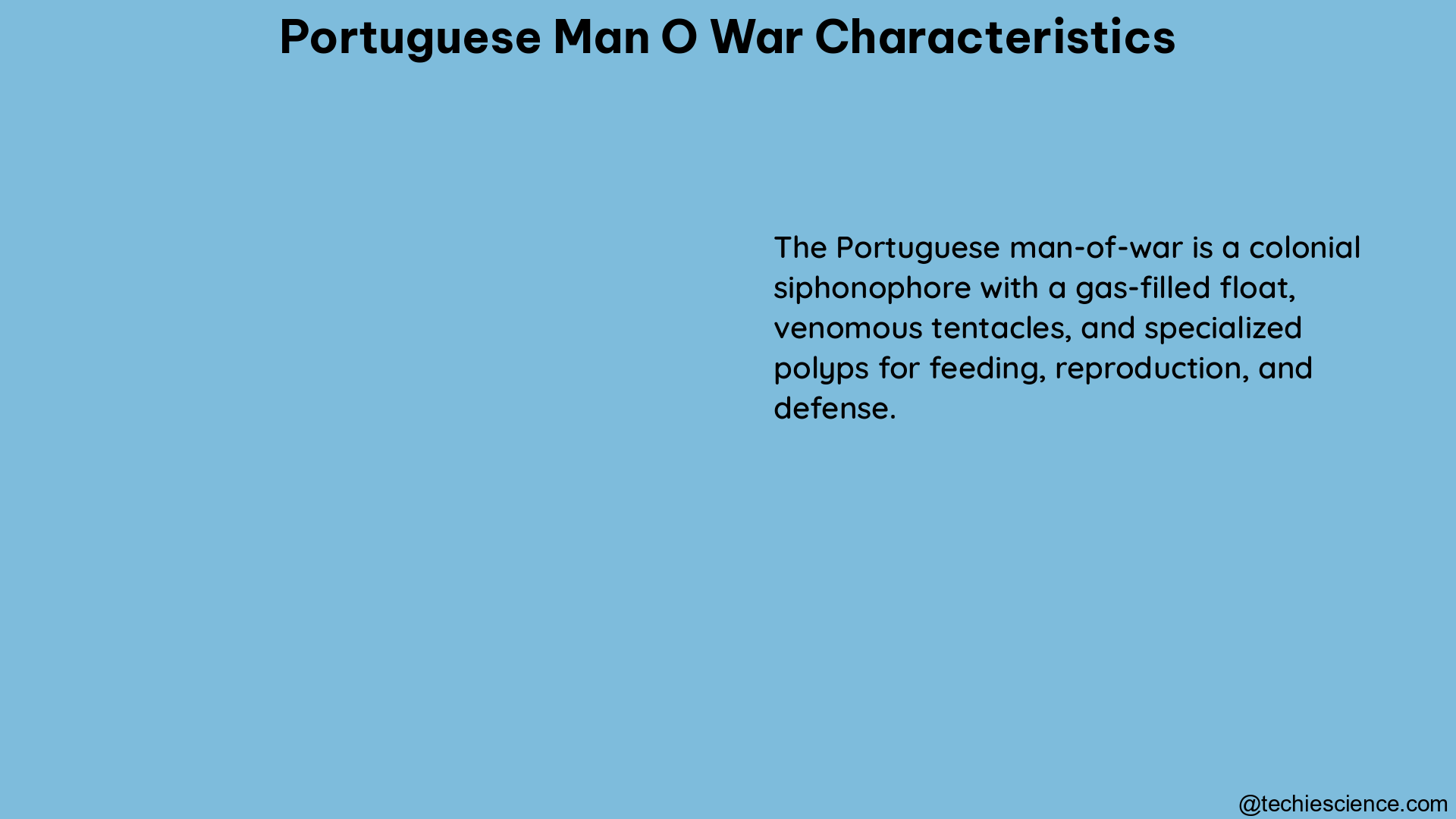The Portuguese man-of-war, scientifically known as Physalia physalis, is a unique and captivating colonial organism found in every ocean except the Arctic. As a siphonophore, it is not a true jellyfish, but rather a collection of specialized zooids working together as a single unit. The man-of-war’s intricate characteristics make it a remarkable and intriguing creature in the animal kingdom.
Colonial Organization: A Specialized Symbiosis
The Portuguese man-of-war is a colonial organism, consisting of four highly specialized parts, each responsible for a specific task:
-
Pneumatophore (Float): This gas-filled bladder, also known as the “sail,” is the most visible part of the man-of-war. It can range in size from a few inches to over a foot long and is filled with carbon monoxide, which is gradually replaced with air, allowing the man-of-war to maintain buoyancy and drift with the winds and ocean currents.
-
Dactylozooids (Tentacles): These long, thin, and highly venomous tentacles can extend up to 165 feet (50 meters) in length and are responsible for capturing prey. They are covered in specialized stinging cells called nematocysts, which deliver a potent venom capable of paralyzing and killing small fish, crustaceans, and even humans.
-
Gastrozooids (Digestive Polyps): These polyp-like structures are responsible for the digestion and absorption of the man-of-war’s prey, which is captured by the dactylozooids.
-
Gonozooids (Reproductive Polyps): These specialized zooids are responsible for the man-of-war’s sexual reproduction, producing both male and female gametes.
The intricate coordination and division of labor among these four specialized parts allow the Portuguese man-of-war to function as a highly efficient and successful colonial organism.
Physiology of the Float: Maintaining Buoyancy

The man-of-war’s float, or pneumatophore, is a remarkable structure that allows it to maintain its position in the water column. The float is filled with a mixture of carbon monoxide and air, with the carbon monoxide gradually being replaced by air over time. This gas composition gives the float the necessary buoyancy to keep the man-of-war afloat, while also allowing it to adjust its position in the water by controlling the ratio of carbon monoxide to air.
The float’s size can vary significantly, ranging from a few inches to over a foot in length. Larger floats generally indicate older, more mature individuals, as the float grows in size as the man-of-war ages. The float’s distinctive purple-blue color is caused by the presence of pigments called carotenoids, which also help to protect the man-of-war from harmful UV radiation.
Tentacles and Venom: A Deadly Sting
The Portuguese man-of-war’s tentacles are its primary means of capturing prey and defending itself. These long, thin, and highly venomous tentacles can extend up to 165 feet (50 meters) in length, making them one of the longest known cnidarian structures. The tentacles are covered in specialized stinging cells called nematocysts, which deliver a potent venom capable of paralyzing and killing small fish, crustaceans, and even humans.
The venom produced by the man-of-war is a complex mixture of proteins, including neurotoxins, cytolysins, and hemolysins. This venom is designed to immobilize and digest the man-of-war’s prey, but it can also be extremely painful and dangerous to humans. Contact with the tentacles can result in a painful sting, causing welts, rashes, and in some cases, more severe reactions, such as muscle spasms, breathing difficulties, and even cardiac distress.
Reproduction: Broadcast Spawning
The Portuguese man-of-war reproduces sexually through a process called broadcast spawning. In this process, the male and female gonozooids release their respective gametes (sperm and eggs) into the water column, where fertilization occurs. The fertilized eggs then develop into free-swimming larvae, known as planulae, which eventually settle and develop into new colonial organisms.
The timing of the man-of-war’s reproductive cycle is closely tied to environmental cues, such as water temperature and lunar cycles. In some regions, the man-of-war may reproduce year-round, while in others, the reproductive season is more defined, typically occurring during the warmer months.
Distribution and Habitat
The Portuguese man-of-war is found in tropical and temperate oceans worldwide, with the exception of the Arctic Ocean. It is a pelagic species, meaning it lives in the open ocean, but can also be found in coastal areas, particularly in areas with strong currents and winds.
The man-of-war’s distribution is largely determined by ocean currents and wind patterns, as its float and tentacles make it well-suited for drifting with the tides and winds. In some regions, such as the Gulf of Mexico and the Caribbean Sea, the man-of-war can be found in large aggregations, or “blooms,” that can stretch for miles.
Predators and Adaptations
Despite its formidable sting, the Portuguese man-of-war has a number of natural predators, including:
- Violet Sea Snail (Janthina janthina): This small sea snail uses a bubble raft to float near the surface and feed on the man-of-war.
- Sea Slugs (Glaucus spp.): Certain species of sea slugs in the genus Glaucus also use a bubble raft to float near the surface and prey on the man-of-war.
To defend against these predators, the man-of-war has developed several adaptations, including:
- Venom Production: The man-of-war’s potent venom is a primary defense mechanism, deterring many potential predators.
- Buoyancy Control: The ability to adjust the gas composition of its float allows the man-of-war to control its position in the water column, making it less vulnerable to surface-dwelling predators.
- Tentacle Retraction: The man-of-war can rapidly retract its long tentacles, making it less vulnerable to attack.
These adaptations, combined with its unique colonial organization and specialized physiology, make the Portuguese man-of-war a highly successful and fascinating creature in the marine ecosystem.
Conclusion
The Portuguese man-of-war is a remarkable and complex colonial organism, with a unique set of characteristics that set it apart from other marine invertebrates. From its intricate division of labor and specialized physiology to its deadly venom and reproductive strategies, the man-of-war is a true marvel of evolution and a testament to the incredible diversity of life in the world’s oceans.
References:
– Five Facts About the Portuguese Man-of-War
– What is a Portuguese Man-of-War?
– Portuguese Man-of-War
– Portuguese Man-of-War

Hello, I am Bhairavi Rathod, I have completed my Master’s in Biotechnology and qualified ICAR NET 2021 in Agricultural Biotechnology. My area of specialization is Integrated Biotechnology. I have the experience to teach and write very complex things in a simple way for learners.